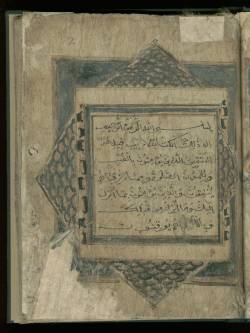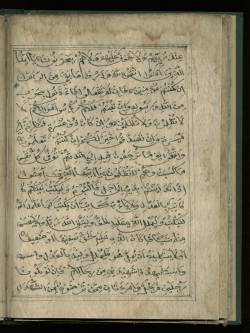Folio 2a |
Folio 1b |
 |
 |
Folio 2a |
Folio 1b |
 |
 |
Folio 25a |
Folio 24b |
 |
 |
|
|
Description
Overall average leaf dimensions: 24.0 cm high x 17.5 cm wide.
Binding dimensions: 25.0 cm high x 18.2 cm wide.
1.8 cm thick (includes covers which are each 0.3 cm thick).
Manuscript written in Arabic an Indonesian naskh script on stiff,
thick dark brownish-grey colored dluang paper (see notes below).
Incomplete manuscript copy of the Qur'an.
Sura 1 through Sura 3 (middle of verse 81).
30 folios.
Undated.
Originally unfoliated, the manuscript has been foliated in pencil
in the upper left hand corner of each leaf.
Folios 1b and 2a contain the opening pages of the text.
Each page has 7 lines of text written in black ink in a fine Indonesian
style naskh script.
The text is enclosed in ornately decorated borders outlined in black ink.
The borders are done in a traditional Indonesian box and triangle pattern
with a stylized peacock feather pattern infilling. Highlighting and infilling
coloring is done in teal (blue ?), pink and yellow. The colors have darkened
and faded over time.
Folio 25b marks the beginning of Sura 3.
The seventh line on the page is the Basmalah. This is contained between
a set of double black rule lines.
Text pages (folios 2b to 30b) each consist of 15 lines of text
enclosed in thin black triple line box borders. The text is written in
black ink in a fine Indonesian naskh script with text markers
enclosed in brown (originally red ?) over black circles.
There are smudges and stains on some of the text pages.
The manuscript shows signs of water staining along the top portion
and upper outer edges of most pages.
There is some minor insect damage to some pages.
The manuscript is in a recent western style, green cloth binding.
New end leaves of yellowish-tan unwatermarked linen paper (chain and rule
lines are visible).
All the pages have been trimmed.
A few pages have marginal notations. These are, in some cases, only partially
present (trimmed off).
Folios 1 through 8 and 30 have been refurbished (edges, corners and holes) with
new and old pieces of dluang paper. Some of the old paper pieces used to
repair the manuscript's pages show traces of writing. It is unclear if the
older paper used for some of the repairs are from the trimmed page edges sections
of this manuscript or another. Though, based on coloring and fiber patterns,
many are clearly derived from the same piece of paper. The repairs are of varying
quality. In some places, the papers have been blended together and in others,
the repair pieces are simply glued on top of the original paper (patches).
The paper repairs, in some places, cover parts of the text.
Notes
Dluang (or Daluang) paper is a traditional paper made in the Indonesian region.
It is a strong and very fibrous type of paper. It manufactured from the bark of the
indigenous saeh tree. The paper is somewhat coarse and displays natural defects (holes,
thin spots and irregular edging). When new, this paper is a light cream-colored brown. In the
the humid climate of the region, it darkens as it ages and will rot. The new paper used for
some of the repairs gives some idea of the original color of the pages.
The decorative colors of the manuscript's double page opening were originally much brighter
and have darkened and faded considerably over time. The originally, much lighter cream color
of the paper, would have nicely contrasted and enhanced the colors, making them more intense
and reminiscent of actual peafowl feathers.
The Indonesian naskh script is very distinctive with its final letters having
long extended flourishes. This script also exhibits angularly constructed left pitched
letters resting on a flat baseline. These are characteristics it shares with the
bihari (or behari) script developed in India.